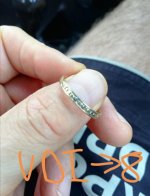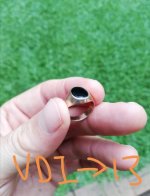I have a good idea of what you mean but would you tell me exactly what your looking for in solid signal. My bet is #s that do not bounce out of range you are looking for.
I can give you an example from a park hunt.
I recently had three obvious targets under my stock 11" coil. I was using a Nox 600 in basic Park 2 with -9 to 0 notched out (luckily I hadn't notched more) and 5 tones. I had a very jumpy 9,10,11,12 target, a fairly solid 13,14 target and a rock solid 18. By rock solid I mean the number 18 and the solid tone did not change during sweeps from any direction and were very steady. Keep in mind, the factory set tone breaks for that range are at 10 and 20 in 5 tones. So the 9,10,11,12 target had two different tones and the 18 was right up against the 20 tone break. Most zinc pennies will have two separate alternating tones on the Nox 600 and so will aluminum trash in the 18, 19 range. The Nox tones will sometimes change across tone breaks without a number change.
If the Nox 600 was not such a good detector it would not have separated these targets so well and I might have walked on thinking it was really big, jagged aluminum or big falsing iron. Thankfully, the Nox has plenty of great features to help identify dig or no dig targets. I hit the horseshoe button to check for iron=none. I used the pinpoint function to size the targets=three separate small coin sized targets. Checked the depth=3 to 6 inches.
9,10,11,12 was a piece of quarter sized jagged can slaw. 13,14 was a modern pull tab. 18 was a Josten's 10K men's class ring. I actually dug the targets in that order, pretty exciting!!!
Most of the men's and women's gold rings I have found along with 1/2 gram sized or bigger gold nuggets have all signaled on the Nox 600 or 800 with a beautiful solid tone and just one numerical target ID number. Smaller gold nuggets, micro gold jewelry and tiny gold chains especially can jump around a bit depending on depth, orientation and ground mineralization.
There are some trashy aluminum, lead, tin, brass and steel targets that will just give solid two number spreads. They will rarely just be one number. It has happened but not often (steel spacers and some bullet slugs). Whenever I get a solid two-way tone (sweeping from more than one direction) and a single number for a coin sized target from surface to 10" depth in the 4 to 21 range on the Equinox, I'm happily digging it. If it is surface to 6" deep and also has a clear double beep, I'm frantically digging it. Usually it is a ring pull without the beaver tail but you never know.......
Jeff



